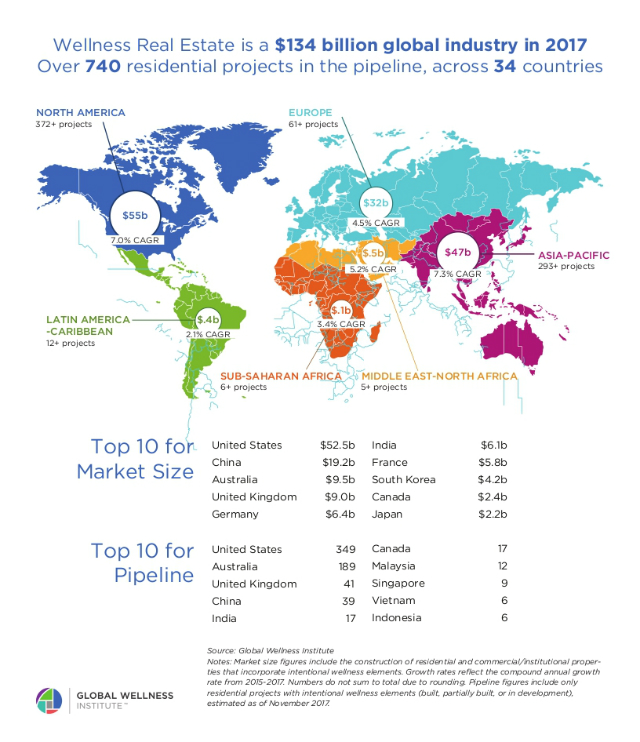Wellness real estate and communities set to be US$180 billion market by 2022
Wellness real estate and communities are “the next frontier in residential real estate” according to new research from the Global Wellness Institute (GWI).
The GWI has released its inaugural report into wellness communities and real estate: Build Well to Live Well.
The report, a preview of which was given at the Global Wellness Summit in October last year, forecast that the international wellness communities/real estate market will see a 6% annual growth in the 2017-2022 period.
The market, valued at US$134 billion (£94bn) in 2017 is predicted to grow to US$180bn (£127bn) by 2022.
The report defines this sector as “real estate and communities that intentionally put people’s health at the centre of design, creation and redevelopment”.
The US is by far the largest market for wellness real estate at the moment, accounting for US$52.5 billion (£73bn), followed by China (US$19.9bn/£14bn), Australia (US$9.5bn/£6.7bn)), the UK (US$9bn/£6.4bn) and Germany (US$6.4bn/£4.5bn).
There are currently around 740 wellness real estate/communities projects around world that have either already been built or are in the pipeline. A further 1.5 million such developments are expected to be built in the next few decades, housing more than 4.1m people.
The leading markets for projects currently at the planning stage are the US, with 355 projects, Australia with 189, the UK with 42, China with 39 and India with 17.
Senior GWI researcher Ophelia Yeung said: “Our existing built environment has a massive and increasingly negative impact on our physical and mental health. We will never address skyrocketing chronic disease and health costs without dramatically transforming where and how we live.”
The report highlighted seven key trends to set to shape the future of the wellness real estate and communities’ market.
These include increasingly blurred lines between home, work and leisure, and ‘healthy homes’ becoming more affordable – with more health-focused accommodation options for those in the lowest income brackets.
The trends predictions also included wellness real estate projects increasingly catering for a multigenerational and socially diverse market, and leading medical companies and facilities coming together to form wellness communities.
The GWI additionally forecast the growth of sustainable residential communities that will seek to not only limit their detrimental impact on the environment but aim to have a positive net effect.
The communities will incorporate elements such as producing their own renewable energy, creating their own healthy food an recycling their water.
We will also, the report stated, see more projects that utilise state-of-the-art technology such as artificial intelligence, telemedicine and smart homes to bring wellness to private homes, neighbourhoods and entire cities.
The final prediction was for more wellness residences to be built around, and with a concept centred on, thermal and mineral springs.Senior GWI research fellow Katherine Johnston said:
“Collectively, we must shake up our thinking: healthy homes are as important as immunisations; parks, paths, and plants are as beneficial as prescriptions; friends and neighbours are far more important than Fitbits.”
To download the full Build Well to Live Well report, click here



